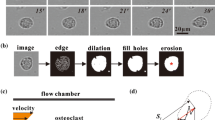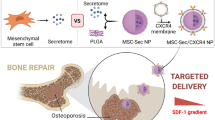Abstract
Tunneling nanotube (TNT)-mediated cell communication play pivotal roles in a series of physiological and pathological processes in multicellular organism. This study was designed to investigate the existence of TNTs between EPCs and osteoclast precursors and evaluate their effects on the differentiation of osteoclast precursors. For these purposes, EPCs and osteoclast precursors (RAW264.7 cells) were stained with different fluorescent dyes before direct co-culture; then, the co-cultured cells were sorted by fluorescence activated cell sorter (FACS), and the differentiation of co-cultured RAW264.7 cells was evaluated. The results showed that the differentiation potential of RAW264.7 cells was significantly inhibited after their co-culture with EPCs. Additionally, the expression of macrophage migration inhibitory factor (MIF) was up-regulated in RAW264.7 cells after co-culture. Moreover, the MIF inhibitor ISO-1 could rescue the formation of TRAP-positive multinuclear osteoclasts and the expression of osteoclastogenesis-associated genes in the co-cultured RAW264.7 cells. The present study demonstrates that EPCs can affect the differentiation of osteoclast precursors through the TNT-like structures formed across these two types of cells and might inform new therapeutic strategies for osteolytic diseases.





Similar content being viewed by others
Abbreviations
- TNT:
-
Tunneling nanotube
- EPCs:
-
Endothelial progenitor cells
- MIF:
-
Macrophage migration inhibitory factor
References
Al-Abed Y et al (2005) ISO-1 binding to the tautomerase active site of MIF inhibits its pro-inflammatory activity and increases survival in severe sepsis. J Biol Chem 280:36541–36544
Bloemen V, Schoenmaker T, de Vries TJ, Everts V (2010) Direct cell-cell contact between periodontal ligament fibroblasts and osteoclast precursors synergistically increases the expression of genes related to osteoclastogenesis. J Cell Physiol 222:565–573
Bloom BR, Bennett B (1966) Mechanism of a reaction in vitro associated with delayed-type hypersensitivity. Science 153:80–82
Canon J et al (2010) (2010) Inhibition of RANKL increases the anti-tumor effect of the EGFR inhibitor panitumumab in a murine model of bone metastasis. Bone 46:1613–1619
Chim SM et al (2013) Angiogenic factors in bone local environment. Cytokine Growth Factor Rev 24:297–310
Coelho RM, Lemos JM, Alho I, Valerio D, Ferreira AR, Costa L, Vinga S (2016) Dynamic modeling of bone metastasis, microenvironment and therapy: Integrating parathyroid hormone (PTH) effect, anti-resorptive and anti-cancer therapy. J Theor Biol 391:1–12
Dumitru CA et al (2011) Tumor-derived macrophage migration inhibitory factor modulates the biology of head and neck cancer cells via neutrophil activation. Int J Cancer 129:859–869
Enoki Y et al (2014) Netrin-4 derived from murine vascular endothelial cells inhibits osteoclast differentiation in vitro and prevents bone loss in vivo. FEBS Lett 588:2262–2269
Fu SL, Pang H, Xu JZ, Wu XH (2014) C/EBPbeta mediates osteoclast recruitment by regulating endothelial progenitor cell expression of SDF-1alpha. PLoS ONE 9:e91217
Gurke S, Barroso JF, Hodneland E, Bukoreshtliev NV, Schlicker O, Gerdes HH (2008) Tunneling nanotube (TNT)-like structures facilitate a constitutive, actomyosin-dependent exchange of endocytic organelles between normal rat kidney cells. Exp Cell Res 314:3669–3683
Ikeda Y, Murakami A, Ohigashi H (2005) Ursolic acid promotes the release of macrophage migration inhibitory factor via ERK2 activation in resting mouse macrophages. Biochem Pharmacol 70:1497–1505
Jacquin C, Koczon-Jaremko B, Aguila HL, Leng L, Bucala R, Kuchel GA, Lee SK (2009) Macrophage migration inhibitory factor inhibits osteoclastogenesis. Bone 45:640–649
Kim J et al (2015) BMP9 Induces Cord Blood-Derived Endothelial Progenitor Cell Differentiation and Ischemic Neovascularization via ALK1. Arterioscler Thromb Vasc Biol 35:2020–2031
Kimura S, Hase K, Ohno H (2012) Tunneling nanotubes: emerging view of their molecular components and formation mechanisms. Exp Cell Res 318:1699–1706
Koyanagi M, Brandes RP, Haendeler J, Zeiher AM, Dimmeler S (2005) Cell-to-cell connection of endothelial progenitor cells with cardiac myocytes by nanotubes: a novel mechanism for cell fate changes? Circ Res 96:1039–1041
Leung R, Wang Y, Cuddy K, Sun C, Magalhaes J, Grynpas M, Glogauer M (2010) Filamin A regulates monocyte migration through Rho small GTPases during osteoclastogenesis. J Bone Miner Res 25:1077–1091
Li RF et al (2014) The adaptor protein p62 is involved in RANKL-induced autophagy and osteoclastogenesis. J Histochem Cytochem 62:879–888
Liu Y, Berendsen AD, Jia S, Lotinun S, Baron R, Ferrara N, Olsen BR (2012) Intracellular VEGF regulates the balance between osteoblast and adipocyte differentiation. J Clin Investig 122:3101–3113
Liu K, Ji K, Guo L, Wu W, Lu H, Shan P, Yan C (2014) Mesenchymal stem cells rescue injured endothelial cells in an in vitro ischemia-reperfusion model via tunneling nanotube like structure-mediated mitochondrial transfer. Microvasc Res 92:10–18
Moon SH, Choi SW, Kim SH (2015) In vitro anti-osteoclastogenic activity of p38 inhibitor doramapimod via inhibiting migration of pre-osteoclasts and NFATc1 activity. J Pharmacol Sci 129:135–142
Mun SH, Won HY, Hernandez P, Aguila HL, Lee SK (2013) Deletion of CD74, a putative MIF receptor, in mice enhances osteoclastogenesis and decreases bone mass. J Bone Miner Res 28:948–959
Okragly AJ et al (2016) Elevated levels of Interleukin (IL)-33 induce bone pathology but absence of IL-33 does not negatively impact normal bone homeostasis. Cytokine 79:66–73
Schmittgen TD, Livak KJ (2008) Analyzing real-time PCR data by the comparative C (T) method. Nat Protoc 3:1101–1108
Sisakhtnezhad S, Khosravi L (2015) Emerging physiological and pathological implications of tunneling nanotubes formation between cells. Eur J Cell Biol 94:429–443
Sowinski S et al (2008) Membrane nanotubes physically connect T cells over long distances presenting a novel route for HIV-1 transmission. Nat Cell Biol 10:211–219
Sun X et al (2012) Tunneling-nanotube direction determination in neurons and astrocytes. Cell Death Dis 3:e438
Takahashi A et al (2013) Tunneling nanotube formation is essential for the regulation of osteoclastogenesis. J Cell Biochem 114:1238–1247
Thayanithy V, Dickson EL, Steer C, Subramanian S, Lou E (2014) Tumor-stromal cross talk: direct cell-to-cell transfer of oncogenic microRNAs via tunneling nanotubes. Transl Res 164:359–365
Urbich C, Dimmeler S (2004) Endothelial progenitor cells: characterization and role in vascular biology. Circ Res 95:343–353
Wang X, Gerdes HH (2012) Long-distance electrical coupling via tunneling nanotubes. Biochim Biophys Acta 1818:2082–2086
Wang X, Veruki ML, Bukoreshtliev NV, Hartveit E, Gerdes HH (2010) Animal cells connected by nanotubes can be electrically coupled through interposed gap-junction channels. Proc Natl Acad Sci USA 107:17194–17199
Yamaguchi M, Ma ZJ (2001) Inhibitory effect of menaquinone-7 (vitamin K2) on osteoclast-like cell formation and osteoclastic bone resorption in rat bone tissues in vitro. Mol Cell Biochem 228:39–47
Yamaguchi M, Weitzmann MN (2011) Zinc stimulates osteoblastogenesis and suppresses osteoclastogenesis by antagonizing NF-kappaB activation. Mol Cell Biochem 355:179–186
Yasuda K, Khandare A, Burianovskyy L, Maruyama S, Zhang F, Nasjletti A, Goligorsky MS (2011) Tunneling nanotubes mediate rescue of prematurely senescent endothelial cells by endothelial progenitors: exchange of lysosomal pool. Aging (Albany NY) 3:597–608
Zhu K et al (2013) ATF4 promotes bone angiogenesis by increasing VEGF expression and release in the bone environment. J Bone Miner Res 28:1870–1884
Zou HX, Jia J, Zhang WF, Sun ZJ, Zhao YF (2013) Propranolol inhibits endothelial progenitor cell homing: a possible treatment mechanism of infantile hemangioma. Cardiovasc Pathol 22:203–210
Funding
This study was supported by the National Natural Science Foundation of China (81570994), National Natural Science Foundation of China (81800946) and National Natural Science Foundation of China (81602780).
Author information
Authors and Affiliations
Corresponding author
Ethics declarations
Conflict of interest
The authors declare that they have no conflict of interest.
Additional information
Publisher's Note
Springer Nature remains neutral with regard to jurisdictional claims in published maps and institutional affiliations.
Rights and permissions
About this article
Cite this article
Li, RF., Zhang, W., Man, QW. et al. Tunneling nanotubes mediate intercellular communication between endothelial progenitor cells and osteoclast precursors. J Mol Hist 50, 483–491 (2019). https://doi.org/10.1007/s10735-019-09842-y
Received:
Accepted:
Published:
Issue Date:
DOI: https://doi.org/10.1007/s10735-019-09842-y




